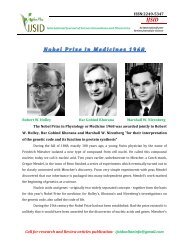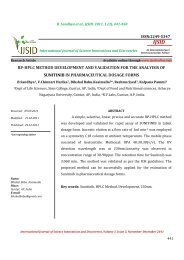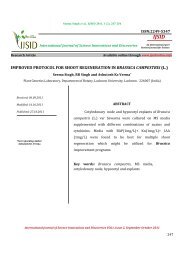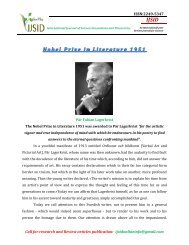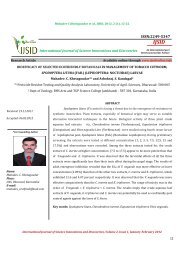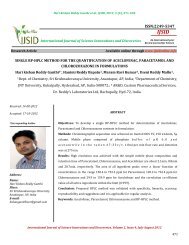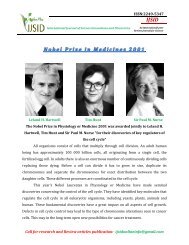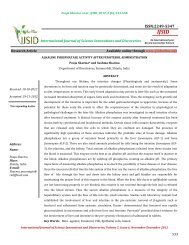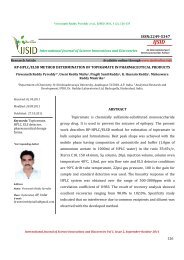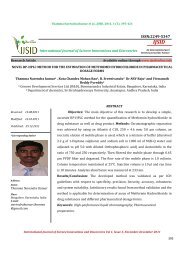(GORO) Abubakar Ahmed - Ijsidonline.info
(GORO) Abubakar Ahmed - Ijsidonline.info
(GORO) Abubakar Ahmed - Ijsidonline.info
You also want an ePaper? Increase the reach of your titles
YUMPU automatically turns print PDFs into web optimized ePapers that Google loves.
<strong>Abubakar</strong> <strong>Ahmed</strong> Hamidu et al., IJSID, 2012, 2 (1), 61-66(i) Test for Flavonoids1ml of the already prepared 10% NaOH was added to 1ml of the extract gradually and then in excess of NaOHsolution. A yellow colourations confirms the presence of flavonoids.(ii) Test for FlavoneIn this test, 5mls of the dissolved extract was taken. To this, some pieces of magnesium chips were added followed byadding concentrated hydrochloride acid drop wise. A vigorous reaction was observed with the generation of heat. A deep redcolour was also observed. This confirms the presence of flavones in the both the back and leaves of cola.(iii) Test for Glycosides5mls of H 2So 4 was heated water bath for 15 minutes. To this 5mls of Fehling’s solution was added and the mixture wasfurther heated. A brick red precipitate confirmed the presence of Glycosides.(iv) Test for PhenolsAn equal volume of the extract was added to equal volume of ferric chloride, a deep blush green colour confirmed thepresence of phenols.(v) Test for Phenolics5mls of the dissolved was taken in this case. To this, a few drops of ferric chloride was added. A yellow colourationconfirmed the presence of phenolics.(vi) Test for Saponins5mls of the dissolved plant extracted i.e. plant and leaves was vigorously shaken with 10mls of distilled water in atest-tube. The frothing which persisted was taken as confirmatory test for the presence of saponins.(E) Thin Layer ChromatographyThis technique was adopted for quantitative analysis of both sugar and non-sugar moieties in the back and leaves ofthe cola natida.The solvent system used was chloroform, methanol and water in the ratios of 35.5: 13.5: and 18 respectively. Theextracts were spotted on the chromatographic plates already prepared and left to stand for 2 hours. This shuns relativemovement of the distance between the centre spot and sample application to the distance between the solvent fronts. This wastaken as RF values.(F) Preparation of Slurry6 grammes of silica gel was weighed with 2 grammes of starch powder i.e. 6:2 ratio slurry paste was made. This wasmixed with 12mls of distilled water to arrive at 1:2 ratio. This was well shaken to achieve homogenization.(G) Slurry ApplicationTwo chromatographic plates measuring 20cm by 20cm were cleaned with distilled water and then acetone. This wasthen dried in an air oven. The slurry was spread uniformly on the plates and fused in an oven.RESULTS AND DISCUSSIONTable 1 shows the result of Phytochemical screening of the extracts of cola natida. (Bark and Leaves).QUALITATIVE ANALYSISBelow are results of chromo + thin layer chromatography of the extracts i.e leave and bark of cola natida for Glyconeand AGLYCON. The TLC calculations for glycoside obtained in the extract as follows. Six spots were developed and Rf valuescalculated as follows: Table IIInternational Journal of Science Innovations and Discoveries, Volume 2, Issue 1, January-February 201264



